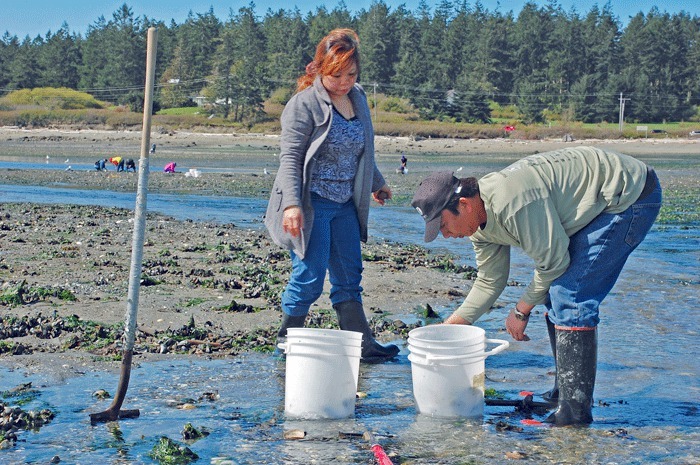While meteorologists are calling this spring one of the coldest on record, an ever-growing presence of shellfish hunters indicates that summer may be just around the corner.
Armed with buckets, shovels, and all the various tools of the clam digging trade, seafood treasure hunters have been spotted scouring Grassers Lagoon with increasing regularity over the past few weeks. Most are taking advantage of spring low tides and brief breaks in the weather.
“The sunshine is really nice,” said Anacortes resident Somchay Soutthivong, during a recent outing on the tide flats at the end of Penn Cove.
He and his wife, Davian, make the 50-minute drive often, but it’s an especially easy choice when the weather is nice, he said. The other 20 or so people on the beach seemed to agree. Some had traveled from as far away as Seattle.
While Grasser’s Lagoon is open to shellfish harvesting year round, people’s willingness to travel may indicate that it won’t be long before summer clamming goes into full swing, said Eugene Thrasher, a Beach Watcher who teaches clamming classes for Island County Washington State University Extension.
“There is really no season for it, but tides are low during the day in the summer months,” Thrasher said.
Island County has a total of 53 places to harvest shellfish but not all are open year round. Some have very defined seasons while others, for a variety of reasons, are closed entirely. For a full map of locations, visit the Washington Department of Fish and Wildlife’s website at wdfw.wa.gov/fishing/shellfish/.
Whidbey Island beaches will usually turn up a variety of clam species, from butters to Manila littlenecks. Those willing to dig a little deeper may be rewarded with the occasional geoduck clam, which can weigh up to 10 pounds.
For the truly adventurous, Thrasher recommends traveling to the coast for razor clams. Digging for the prized mollusks is limited to just four locations: Long Beach, Twin Harbors, Copalis, Mocrocks, and Kalaloch. The season is short and can be pretty competitive, even with a bag limit of 15 clams.
“There a lot of people out there,” Thrasher said. “I’ve been there and looking up and down the beach all you see is people, elbow to elbow.”
If you are clamming on Whidbey Island, make sure to check the state Department of Health’s website for a list of beach closures. Fish and Wildlife monitors seasons and regulations, but the health department is charged with monitoring which areas are safe from marine biotoxins and vibrio.
For more information about areas closed to shellfish harvesting, visit the agency’s website at ww4.doh.wa.gov/gis/mogifs/biotoxin.htm or call 1-800-562-5632.
Thrasher teaches annual classes called “Digging for Dinner” on North and South Whidbey. Classes are usually held in June and July. For dates, call 679-7327.



